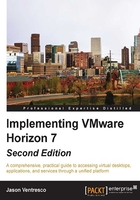
Why virtualize our end user computing resources?
There are a number of different reasons why an organization may decide to implement VMware Horizon in their own environment. Many organizations are already familiar with the benefits of virtualization, such as the following:
- Server consolidation: Less physical hardware is required to service the same quality of workload
- Simplified management: Fewer physical resources to manage
- More energy efficient: Less power and cooling required
- Hardware independence: Virtual machines can run on almost any hardware platform without any changes required
- Enhanced capabilities: Deploy new virtual servers much faster than physical ones, and with less effort
These are just a small sample of the benefits of virtualization. If you have already implemented virtualization in your organization, you likely have additional reasons of your own.
Virtual desktops and applications can provide an organization with additional advantages beyond those of virtualization itself. Using VMware Horizon, we can do the following:
- Roll out a new Windows desktop OS across your enterprise without making any changes to the existing desktops, although eventually you will want to retire or repurpose these machines.
- Horizon desktops are live in the data center, and they can be accessed from almost anywhere from a variety of clients. Horizon desktops, as well as the data stored on them, can't be left in airports, stolen from cars, or accidentally left on your desk at the office. Horizon offers the ability to control it and how data can be copied between the client endpoint and the desktop or application being accessed.
- Stop caring about endpoint hardware. Use existing Windows PCs as desktops if you want or move to a zero client and do away with common endpoint management tasks. Better yet, have users bring their own device and let them use it to access their Horizon desktop. Worry about what's in the data center, not on the desk.
- Microsoft Patch Tuesday redefined. With Horizon Instant and linked clones, you patch once and then quickly update the desktops with a whole new master image. No more testing patches across 15 different hardware platforms. No more monitoring patch status across hundreds or thousands of desktops. The same technique can be used to roll out new applications as well.
- Stop troubleshooting random desktop problems. Problems with Windows? Provide the user a new or refreshed desktop in minutes with linked clones, or even seconds with instant clones. With features such as User Environment Manager to manage Windows profiles and App Volumes to deliver applications on demand, the individual desktop doesn't have to matter. If a problem with a persistent desktop will take more than a few minutes to fix, refresh the desktop instead. If using nonpersistent desktops, simply ask the user to log off and on again, which will assign them a brand new desktop to use.
These are just some of the advantages of using VMware Horizon, vSphere, App Volumes, and User Environment Manager to move your desktops and applications into a data centre. While reading this book, I encourage you to think of ways that Horizon can change how you provide end user computing resources to your organization. These are just a few examples:
- Don't just simply forklift your desktops into the data center as full virtual machines, consider the benefits of linked or instant clones.
- Rather than create large numbers of master images for different departments or worker types across your organization, create a basic image that you can layer applications on top of using App Volumes.
- Investigate software that is optimized for virtual desktops, such as the vShield Endpoint antivirus platform. Software that is optimized for virtual desktop platforms typically requires less per-desktop resources, which may enable you to run more desktops on a given vSphere host.
- Horizon Enterprise has features that make the individual desktop less important, you just need to use them. Use User Environment Management to manage your users' Windows profiles, App Volumes to centrally manage and deliver applications independent of the desktop, and suddenly the individual desktop won't matter as much. This allows you to focus on the only things that actually matter: user data and applications.
VMware Horizon, App Volumes, and User Environment Manager can provide you with much more than just a means of virtualizing your desktops and applications. The more familiar you become each product's features and capabilities, the more you will realize that you can rethink a lot of what you do concerning application and desktop management and delivery, and eventually provide a higher quality experience to your end users.
I certainly hope this is the case.